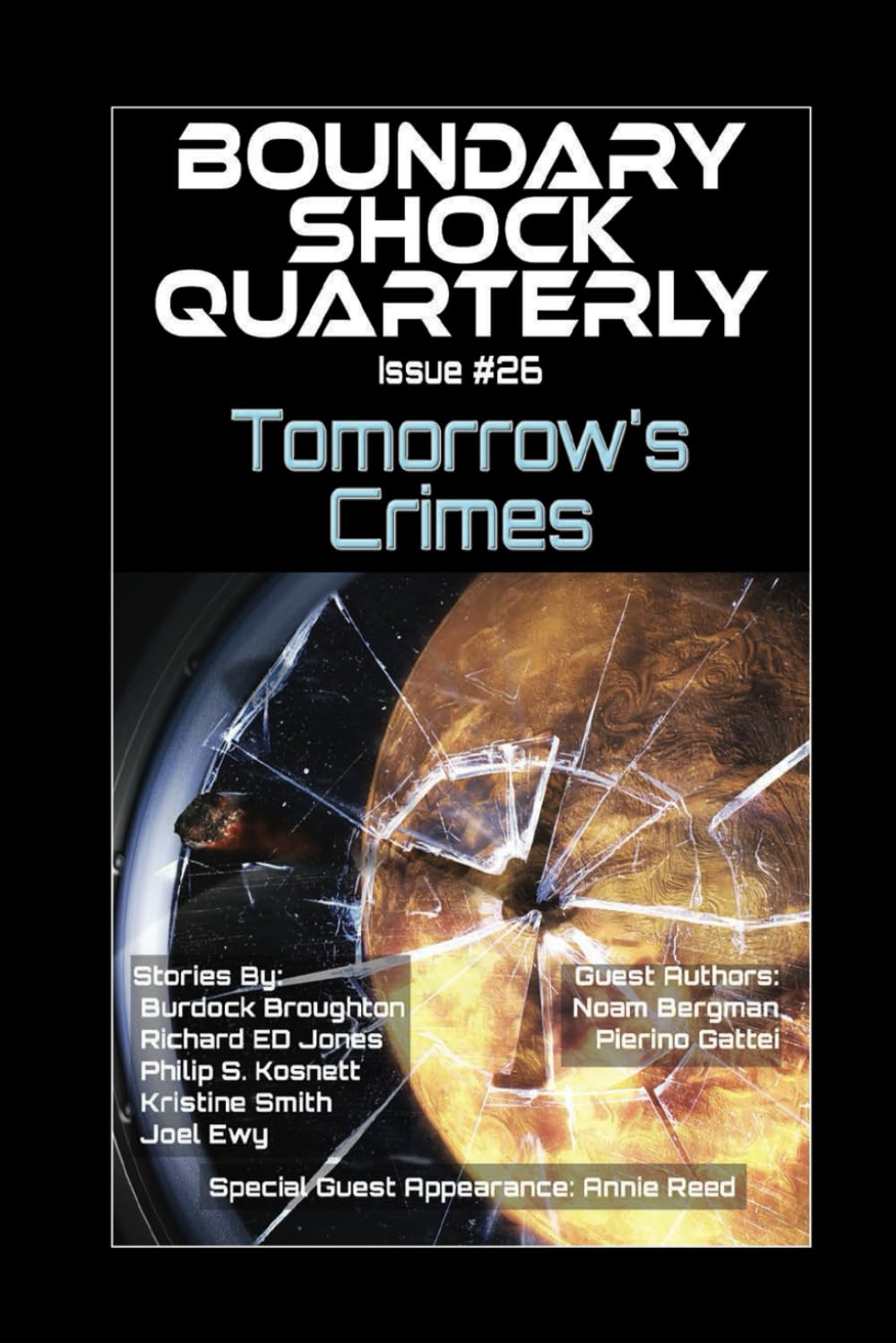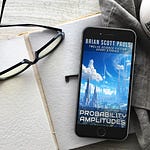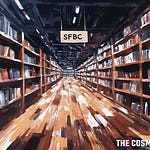My novelette, An Illicit Mercy, is part of a new promotion in May and June, Science Fiction & Fantasy Reads.
Check out over 80 books available for free.
My latest novelette, “Long Night On the Endless City,” appears in Boundary Shock Quarterly 26: Tomorrow’s Crimes:
On the vast ring habitat Ouroboros, Jel and her synthetic companion Marcus search for Arja, the third member of their triad. This quest leads them to a cryptic technology cult with questionable motives. When they suffer a vicious attack, Marcus and Jel join forces with one of Ouroboros’most renowned computer and robotics experts to get to the bottom of the mystery.
This thought-provoking sf tale explores artificial intelligence, religion, and the ties that bind families together in a fast-paced story full of action, intrigue, and heart.
Get your FREE copy of Elemental by Liane Mahugh
Raya's ability to control the elements is more than a way of life - it could be her death sentence. Sent on a solo mission to Earth, she runs into trouble when her ship crashes near a small town. Will her supernatural powers be enough to keep her safe on this unfamiliar world?
For Raya to make it home, she must learn to trust the teens who befriend her while keeping the truth about her mission a secret from them. It doesn't take long for her new friends to wonder: was she sent to help, or destroy us?
Read Elemental now to find out if Raya will triumph or be taken down as a threat to mankind.
Elemental is the first in the series. Be sure to follow-up with Book 2 - Down Comes the Dark.
The science fiction young adult novel (or “juvenile,” as it used to be called) has been with us since Robert A. Heinlein published Rocket Ship Galileo in 1947.
While they may not have been labeled as such, many of Andre Norton’s science fiction novels also read like juveniles. Her protagonist is usually a young adult, almost always an orphan, who has to find his (most are young men) way in the galaxy. In my hometown library, this ambiguity caused Norton’s duology The Zero Stone (1968) and Uncharted Stars (1969) to be cataloged with the children’s books. Meanwhile, I could find the very similar Sargasso of Space (1955), Plague Ship (1956), and Voodoo Planet (1959) in the adult section.
While the library may have been confused, sf readers weren’t. In 2005, the year Norton died, the Young Adult Fiction Committee for the Science Fiction and Fantasy Writers Association created the Andre Norton Award for Young Adult Science Fiction and Fantasy, since renamed the Andre Norton Nebula Award for Middle Grade and Young Adult Fiction.
Charlie Jane Anders received the Locus Award for Best Young Adult Novel in 2023 for Dreams Bigger Than Heartbreak, the middle book of her Unstoppable space adventure trilogy.
Anders tells the story of several teenagers from Earth who’ve been transported to the multi-species galactic civilization known as the Firmament, which is protected by the Royal Fleet. The protagonist is Tina Mains—an adolescent who is also an immature clone of Captain Thaoh Argentian, hero of the Royal Fleet. A procedure to restore Argentian’s memories doesn’t work as expected, so for the most part, Tina must manage using her own resources and those of her friends.
The previous volume, Victories Greater than Death, ended with a big win pointing to deeper, darker mysteries. The middle book explores where each of the kids go in their new lives, including their relationships with one another and those they meet along the way.
With this novel, Anders continues her examination of two main themes from the first book and elevates another to primary status.
Gender identity is one significant theme, including how languages refer to this characteristic. Members of the Royal Fleet, as well as other citizens of the Firmament, often introduce themselves to new acquaintances by providing both their name and their preferred pronoun. Automatic translation accommodates the gender-fluid by updating those they meet regarding their current pronoun.
Informed consent is another theme carried over from the previous novel. This topic comes up frequently in conversations between the teenagers, whether they are close friends or dating one another.
Cultural imperialism is the newly-elevated theme. While the first book touched on this idea, developments during the novel’s climax make it a major concern in Dreams Bigger Than Heartbreak.
This is a lot of territory to cover in a young adult book, and for the most part Anders pulls it off.
She aptly handles a large cast without confusing readers about what’s going on or who’s doing it. In this volume, she innovates on the structure of the first book by labeling sections with the name of the current point-of-view character. This helps prevent the reader from getting lost in the details and keeps the overall storyline clear.
Anders is talented at describing non-human species in evocative ways. Take, for example, the description of Zaeta, an intelligent alien with a multitude of eyes,
“Zaeta’s eyes are divided into three groups. The top layer, near her forehead, express what she's thinking—like, the way she thinks she ought to feel, not the way she does feel. The eyes on the left side of her face express the hopeful, joyful part of her, the part that reaches out for connection with other people. And the right side is the scared, worried angry part of her that second-guesses everything and wants to push everyone away. When she’s really happy, or really sad, all ninety-nine of her eyes look the same.”1
This passages captures not only the physical arrangement of Zaeta’s eyes, but also how they reflect what’s going on in her mind. This is a level beyond a merely functional description and helps make the character convincing.
Anders also includes nuggets of fascinating world-building that give readers the feeling there is so much more to the galaxy beyond the small part the book describes in detail.
Take, for instance, this brief peek into the economy of another species:
“Yatto told Elza Irriyaians use money, just like on Earth—except for two differences:
But verisimilitude can be a two-edged sword. Anders tends to take it to the extreme. An interesting detail here or there creates the illusion of a larger world. Too many place readers at risk of missing gems like the one above in a flood of the fascinating but irrelevant.
Other aspects of the book that disappointed me included Star Trek Syndrome, wrong science, and Anders’ choice of how to handle personal pronouns.
“Star Trek Syndrome” is my term for the homogenization effect the past sixty years of television and movies have had on science fiction literature. Tropes adopted by script writers, producers, and directors, which are necessarily shaped by the physical and budgetary constraints of working on Earth in the 21st century, have become default assumptions shared by many of today’s science fiction writers. Our genre has a long history of imaginative aliens, extraterrestrial cultures, different types of space travel, and approaches to inter-species communication. But stories derivative of Star Trek and Star Wars tend to feature lots of humanoid aliens, despite how unlikely this might be. And they often include massive starships which can ignore inertia through the magic of artificial gravity, galactic communities with “universal translation,” and “exotic” worlds where the gravity and atmospheres are surprisingly similar to Earth.
It’s too bad Star Trek Syndrome is on full display in the Unstoppable books. Anders is a talented writer who could give us a unique universe if she so desired.
A “relaxed” approach to the science in science fiction often goes hand-in-hand with Star Trek Syndrome. In the Acknowledgement section of Victories Greater Than Death, Anders thanks two people for their help with “the science stuff.” I commend her for seeking advice in this area, as well as on sensitive topics such as cultures, languages, and gender orientations. But the science that shows up on the page remains unconvincing.
I hold to the distinction George Ochoa and Jeffrey Osler make in The Writer’s Guide to Creating a Science Fiction Universe between “imaginary science” and “wrong science.”4 Most, if not all, science fiction writers use imaginary science, where they extrapolate from existing theory to create a solution to a speculative story problem. Classic examples include faster-than-light drives and time machines. No one knows how to make either, and both are probably impossible. But although it isn’t easy, we can posit potential workarounds which respect what we currently know about the universe.
Wrong science doesn’t respect what we already know. It plays fast and loose with the laws of physics and makes no apologies for leaving them in tatters.
Anders falters in this fashion. Let’s look at a couple of examples.
At one point in Dreams Bigger Than Heartbreak, the kids take part in a public event witnessing and celebrating the death of an artificial sun and the ignition of another to replace it. In the brief interval between the dying of the old sun and the birth of the new, the Firmament’s capital experiences total darkness.
I’ve no issue with the idea of artificial suns. This is a wonderful use of imaginary science. My problem comes with this detail:
“Ken brought some blackout wine, which Ganno says is designed to strengthen your eyes, so you can see your friends after the light is gone.”5
There’s a disconnect here. I believe even readers with no great interest in science might find it jarring. Imagine an author told you their characters were subjected to a field which would fully suppress all sound waves, so that within the field no sound is possible. What if they then said one of the characters had a gadget which would enhance their hearing, so they could hear sounds within the field. If no sound is possible, no amount of enhancement will help. It doesn’t matter if the gadget multiplied the sensitivity of the character’s hearing two, three or four times. Anything multiplied by zero is zero.
The same is true in total darkness. If there is no light at all (as we are told is the case during the ceremony) it doesn’t matter how good your eyesight may be. No light. No vision.
A different sort of error appears when Tina explains to her best friend Rachael how she can call for help using one of two quantum-entangled particles:
“‘This was in a tiny box of Captain Argentian’s things,’ Tina hands half the necklace to Rachael. ‘Each of these halves contains a tiny particle, and they’re quantum-entangled.’”
“‘Quantum entangled.’ Rachael struggles to remember her dad’s home-schooling physics lessons. ‘That means no matter how far apart they are, whatever happens to one particle affects the other.’”
“‘They’re linked,’ Tina says. Across any distance. Millions of light-years away, one gemstone will still speak to the other. So if you find yourself in a bad situation, break the seal on this one, and I’ll come find you, wherever you are.’”6
Quantum information is complicated and counter-intuitive, so Anders isn’t the first to speculate quantum-entangled particles could be used for instantaneous communication. The problem is this violates Einstein’s theory of special relativity, which holds that nothing can travel faster than light—including information. It doesn’t matter if that information is the full contents of Wikipedia or a single bit signifying a seal has been broken. While entanglement is astounding and even useful, it can’t be used to transmit data. That must travel along a “classical” channel like a radio wave or a laser beam, subject to all the limitations of communicating across interstellar distances. This is why the next generation of computer networks we’re now building, while based on quantum entanglement, will still be restricted to the speed of light.
Why is this important? Can’t we just have fun?
Sure we can. But I agree with Carl Sagan, who once told Johnny Carson on an episode of The Tonight Show:
“‘…my sense is that every [motion] picture which touches on science could do that and at the same time, [expend] just a little more effort to get the science right…’”
To the extent that literature is a more thoughtful medium than television or movies, it’s critical to apply Sagan’s statement to books. Science is important, particularly for kids who might want to go into STEM. I probably learned more science from science fiction than I learned in my high school and college science classes—precisely because reading sf was more fun than schoolwork. I can’t tell you much about what I learned dissecting a frog, but science fiction taught me the only forms of artificial gravity we know how to create preclude how it works on the Enterprise.
Pronouns are one of the most important themes in the Unstoppable trilogy. But I found Anders’ style in this regard repetitive and somewhat grating.
She typically handles pronouns by having characters introduce themselves in this way:
“‘My name is Rachael and my pronoun is she.’”7
The Firmament and the Royal Fleet use this as a formalized greeting structure. So it doesn’t just happen once or twice. It happens over and over again.
Anders does this to reinforce her theme. But it’s not interesting writing. And it raises a number of questions, such as why are gender pronouns a universal issue in a multi-species society? Do all aliens have multiple genders? Have they all developed gendered language?
The latter seems unlikely. Not even all human languages are gendered. Mandarin, for example, uses the same pronoun regardless of the sex of the person to whom it refers. My adopted daughter, who otherwise learned English with great ease, found this difference confusing.
Through the character of Wyndgonk, Anders demonstrates she knows how to handle pronouns in a more elegant fashion, and in the process make them more interesting:
“‘My name is Wyndgonk, and my pronoun is fire. I’m from Thythutny.’ As usual, Elza somehow knows this person has a nonstandard pronouns thanks to the EverySpeak, even though it breaks Portuguese grammar in a dozen ways. (She’s pretty sure the pronouns in a lot of these alien languages don’t work the same as in most human languages. Maybe instead of being about gender, they let you know someone’s status, or job or affiliation.)”8
This is great writing and great sf. Different species use pronouns differently. The way aliens use them may not even register as “pronouns” in Earth languages. And if everyone automatically knows the pronouns preferred by the people they meet, there’s no need for a formal and cumbersome introductory ritual. Just portray the characters using the pronouns. If someone named “Riley” shows up, have the other characters just start referring to them as “they,” “he,” “she,” or “fire,” whatever’s appropriate.
I know Anders wants to make sure her readers understand an important message. But in general, readers are smart. They get it. They don’t need the author to drive the point home. More often than not, less is more. And it’s almost always more fun to read.
Dreams Bigger Than Heartbreak is a good young adult science fiction novel for readers looking for a story that explores themes of openness and inclusion, and for those who want the science fiction setting equivalent of comfort-food. It may not challenge or edify your understanding of science, but it you take its themes seriously, it might make you a better person. I’ve got the third volume, Promises Stronger Than Darkness, waiting on my nightstand.
Have you read the Unstoppable trilogy? Do you plan to? Please share your thoughts!
Charlie Jane Anders, Dreams Bigger Than Heartbreak, Tor, 2022, p. 97
This is a real-world suggestion: https://www.noemamag.com/what-if-money-expired/
Charlie Jane Anders, Dreams Bigger Than Heartbreak, Tor, 2022, p. 165
George Ochoa and Jeffrey Osier, The Writer’s Guide to Creating a Science Fiction Universe, Writer’s Digest Books, p. 3
Charlie Jane Anders, Dreams Bigger Than Heartbreak, Tor, 2022, p. 98
Charlie Jane Anders, Dreams Bigger Than Heartbreak, Tor, 2022, p. 143
Charlie Jane Anders, Dreams Bigger Than Heartbreak, Tor, 2022, p. 52
Charlie Jane Anders, Dreams Bigger Than Heartbreak, Tor, 2022, p. 38
















